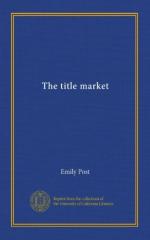But Christopher Shayne was more than skeptical about the duke’s disinterestedness. “There is a rake-off for this one somewhere,” he thought. He also thought that for once he had been mistaken in his judgment of character. Sansevero had been, in his opinion, a man who would sooner starve than defraud the government. So strongly did he believe this that although he had, as the duke knew, long coveted the Raphael, he would never have dared to approach Sansevero.
After the duke had gone Shayne went out and personally sent a code cable announcing his purchase.
“Well,” he said to himself, “it’s no business of mine. But duke or no duke, he is a slick one. I don’t like him. I can tell, though, whether it is the Sansevero picture as soon as I lay my eyes on it—but what gets me is that the prince chose such a go-between. Why didn’t he come to me direct?” He didn’t puzzle over that long, however; planning to get the picture out of Italy occupied his attention. An excellent idea presented itself: some furniture ordered by his firm should carry it in a sofa, and his partner should be advised by cipher letter to remove the picture. J. B. Randolph would buy it, without doubt—no need to tell him how it came into Shayne & Co.’s hands. They could swear they bought it in London. Plausible stories of masterpieces discovered in out of the way corners were easily enough manufactured. So these thoughts all being to his utmost satisfaction, he went whistling down the street.
The Duke Scorpa at the same time was being driven cheerfully homeward. That had been a stroke, that idea of pretending he was merely the intermediary. He had got the picture for a loan of one hundred thousand, and had one hundred and fifty thousand clear profit. There was nothing to show his transaction with Sansevero. No money had passed between them, not even a scrap of paper. He had torn up the prince’s I. O. U., and that was all the evidence there had been. Christopher Shayne, besides, was a shrewd man and reliable, and one who never had been caught in a questionable transaction. To be sure, Scorpa had given Sansevero his word (but again there was no proof), that he would let him retrieve the picture at an advanced price that should be merely the accrued compound interest on the money lent. In case of his being able to reclaim it, Scorpa would pretend that the picture was burnt or stolen—time enough to cross bridges when he came to them. But that chance was beyond all probability. There was no way for Sansevero ever to secure enough money to get back the picture—unless, indeed, his younger brother Giovanni should marry the great American heiress who was on her way to Italy for the winter.
“I hardly think that likely,” said the Duke Scorpa to himself, as he stroked his heavy chin with his fat hand, “for I intend to annex that little fortune myself.”




